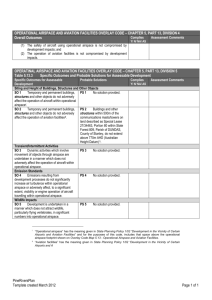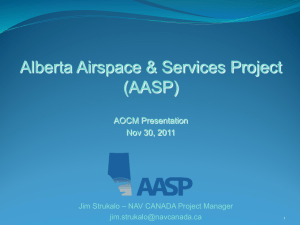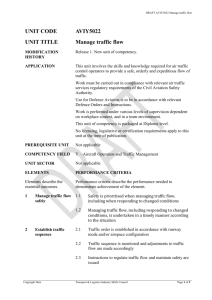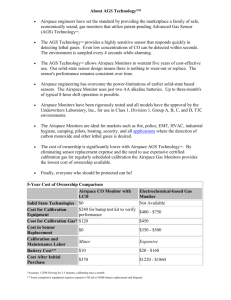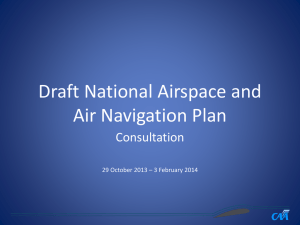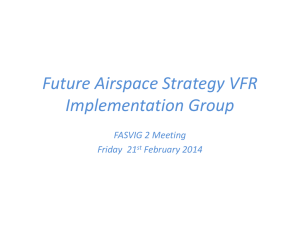National Airspace System - The Mount Point
advertisement
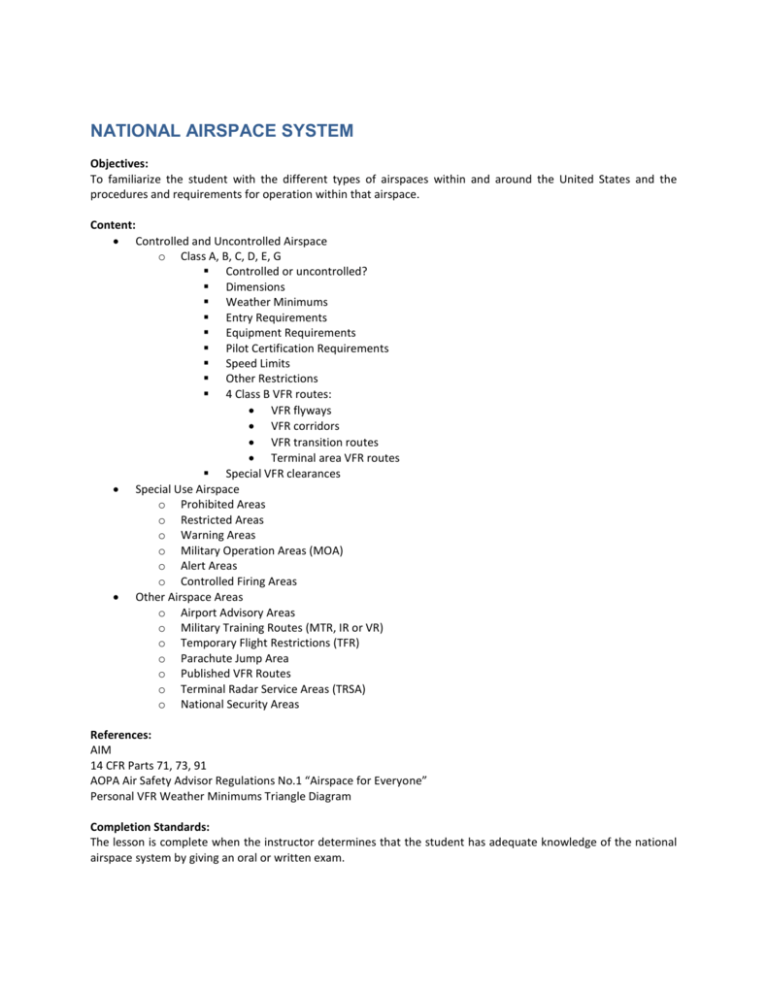
NATIONAL AIRSPACE SYSTEM Objectives: To familiarize the student with the different types of airspaces within and around the United States and the procedures and requirements for operation within that airspace. Content: Controlled and Uncontrolled Airspace o Class A, B, C, D, E, G Controlled or uncontrolled? Dimensions Weather Minimums Entry Requirements Equipment Requirements Pilot Certification Requirements Speed Limits Other Restrictions 4 Class B VFR routes: VFR flyways VFR corridors VFR transition routes Terminal area VFR routes Special VFR clearances Special Use Airspace o Prohibited Areas o Restricted Areas o Warning Areas o Military Operation Areas (MOA) o Alert Areas o Controlled Firing Areas Other Airspace Areas o Airport Advisory Areas o Military Training Routes (MTR, IR or VR) o Temporary Flight Restrictions (TFR) o Parachute Jump Area o Published VFR Routes o Terminal Radar Service Areas (TRSA) o National Security Areas References: AIM 14 CFR Parts 71, 73, 91 AOPA Air Safety Advisor Regulations No.1 “Airspace for Everyone” Personal VFR Weather Minimums Triangle Diagram Completion Standards: The lesson is complete when the instructor determines that the student has adequate knowledge of the national airspace system by giving an oral or written exam. Instructor Notes: Airspace Classes (Pilot’s Encyclopedia; AIM 3-2-1) o Class E Airspace Definition Generally controlled airspace that is not designated A, B, C, or D Where the majority of your flying time will be Operating Rules and Pilot/Equipment Requirements Previously established rules apply: o Transponder above 10,000 Transponder Requirements (91.215(d)) At or above 10,000’ MSL o Excluding airspace below 2,500’ AGL Within 30 miles of a class B airspace primary airport, below 10,000’ MSL Within and above all Class C airspace, up to 10,000’ MSL Within 10 miles of certain designated airports o Excluding airspace which is both outside the Class D surface area and below 1,200’ AGL Flying into, within, or across the ADIZ o Airspeeds (91.117) No more than 250 knots below 10,000’ MSL Below 2,500’ AGL within 4 nm of the primary class C, D airspace not over 200 knots Underlying Class B airspace designated for an airport or in a VFR corridor designated through class B airspace not over 200 knots Pilot Qualifications: Student Pilot ATC Services There are no communication requirements flying VFR but you can request traffic advisory services from ATC o Provided on workload-permitting basis Vertical Limits Unless designated at a lower altitude, Class E Airspace begins at 14,500’ MSL to, but not including, 18,000’ MSL overlying: o The 48 contiguous states including the waters within 12 miles from the coast o The District of Columbia o Alaska Extends upward from either the surface or a designated altitude to the overlying or adjacent controlled airspace Segments of Class E Airspace Class E and the Low Altitude Airway System o Connects one navaid to another VOR to VOR (Victor Airways) o Unless otherwise specified, they extend upward from 1,200’ to, but not including, 18,000’ MSL Mountainous terrain may have a floor above 1,200’ o Airways are usually 8 nm wide o Class E and Airports o Extension to a Surface Area There are Class E airspace areas that serve as extensions to Class B, Class C, and Class D surface areas designated for an airport. Such airspace provides controlled airspace to contain standard instrument approach procedures without imposing a communications requirement on pilots operating VFR EX: Athens – Class E Surface Area EX: Washington Wilkes – Class E extension o Airspace Used for Transition Allow IFR traffic to remain in controlled airspace while transitioning between the enroute and airport environments There are Class E airspace areas beginning at either 700’ or 1,200’ AGL used to transition to/from the terminal or en route environment EX: Baldwin?? When needed for IFR control purposes o En Route Domestic Areas Provide controlled airspace in those areas where there is a requirement to provide IFR en route ATC services but the Federal Airway System is inadequate Airspace areas that extend upward from a specified altitude as an en route domestic airspace o Offshore Airspace Areas provide IFR en route ATC services and within which the US is applying domestic procedures Airspace areas extending upward from a specified altitude to, but not including, 18,000’ MSL to provide controlled airspace beyond 12 miles from the coast of the US Class D Airspace Definition Generally extends from the surface to 2,500 feet above the airport elevation Normally 4 nm radius o Changes depending on needs These airports have a part time operational control tower o Class D only when the tower is in operation o Otherwise Class E The configuration of Class D airspace is configured to meet the operational needs/instrument procedures of the area Operating Rules and Pilot/Equipment Requirements Pilot Certification o No specific certification required Equipment o Two-way radio Must establish two-way radio communication with the tower prior to entering the airspace o o Class C Airspace Definition Generally extends from the surface to 4,000 feet above the airport elevation These airports have an operational control tower and are serviced by a radar approach control, and with a certain number of IFR operations or passenger enplanements The airspace usually consists of a 5 NM radius core surface area that extends from the surface to 4,000 feet above airport elevation, and a 10 NM radius shelf area that extends from 1,200 feet to 4,000 feet above the airport elevation Operating Rules and Pilot/Equipment Requirements Pilot Certification o No specific certification required Equipment o Two-way radio Must establish two-way radio communication with ATC prior to entering the airspace o Operable radar beacon transponder with automatic altitude reporting equipment Class B Airspace Definition Generally the airspace from the surface to 10,000 feet MSL surrounding the nation’s busiest airports (IFR traffic) The configuration of Class B airspace is individually tailored to the needs of a particular area and consists of a surface area and two or more layers o Represents an upside down wedding cake o Designed to contain all instrument procedures once entered Operating Rules and Pilot/Equipment Requirements For VFR Operations: o At least a Private Pilot Certificate is required Exception: student/recreational pilots seeking private pilot certification with an endorsement (CFR 61.95) o ATC Clearance is required before entering o Must be equipped with an operable two-way radio o 4096-code Mode C transponder o Mode C Veil Airspace within 30 nm of a primary Class B airport, from the surface to 10,000’ MSL Aircraft operating in this airspace must be equipped with automatic pressure altitude reporting equipment having Mode C capability For IFR operations: o An operable VOR or TACAN receiver o An operable radar beacon transponder with automatic altitude reporting equipment o Class A Airspace Generally the airspace from 18,000 feet MSL up to and including FL600, including the airspace overlying the waters within 12 NM of the coast of the 48 contiguous states and Alaska Operating Rules and Pilot/Equipment Requirements Unless otherwise authorized, all operation in Class A airspace will be conducted under IFR o Class G Airspace Definition Uncontrolled Airspace The portion of airspace that has not been designated as Class A, B, C, D, or E Extends from the surface to the base of the overlying Class E airspace Although ATC has no authority/responsibility to control air traffic here, there are VFR minimums which apply to Class G airspace Special Use Airspace o Special Use airspace exists where activities must be confined because of their nature. In special use airspace, limitations may be placed on aircraft that are not a part of the activities. o Prohibited Areas Airspace within which the flight of aircraft is prohibited Established for security or other purposes associated with the national welfare Published in the Federal Register and are depicted on aeronautical charts o Restricted Areas Airspace within which the flight of aircraft, while not wholly prohibited, is subject to restrictions Denote the existence of unusual, often invisible hazards to aircraft Such as artillery firing, aerial gunnery, or guided missiles An aircraft may not enter a restricted area unless permission has been obtained from the controlling agency If it is not active ATC will allow the aircraft to operate in the airspace If it is active the ATC will ensure the aircraft avoids the restricted area Restricted areas are depicted on aeronautical charts and are published in the Federal Register o Warning Areas Airspace extending from 3 nm outward from the coast of the US, that may be hazardous to nonparticipating aircraft The activities may be much the same as those for a restricted area The purpose is to warn nonparticipating pilots of the potential danger They are depicted on aeronautical charts o MOAs (Military Operation Areas) Consist of airspace established for the purpose of separating certain military training activity from IFR traffic IFR traffic may be cleared through a MOA if IFR separation can be provided by ATC, otherwise ATC will reroute the traffic There is no restriction against a pilot operating VFR in these areas o A pilot should, although, be alert since training activities may include aerobatic and abrupt maneuvers MOAs are depicted on aeronautical charts o Alert Areas Are to advise pilots that a high volume of pilot training or unusual aerial activity is taking place They are depicted on aeronautical charts o Controlled Firing Areas Contain activities, which, if not conducted in a controlled environment, could be hazardous to nonparticipating aircraft Activities here must be suspended when a spotter aircraft, radar, or ground lookout position indicates an aircraft might be approaching the area No need to chart since they do not cause a nonparticipating aircraft to change its flight path Other Airspace Areas o Airport Advisory Areas An area within 10 SM of an airport where a control tower is not operating, but where a FSS is located At these locations, the FSS provides advisory service to arriving and departing aircraft o Military Training Routes Developed to allow the military to conduct low-altitude, high-speed training. The routes above 1,500 feet AGL are developed to be flown primarily under IFR, and the routes 1,500 feet AGL and less are for VFR flight The routes are identified on sectional charts by the designation “instrument (IR) or visual (VR)” o Temporary Flight Restrictions (TFRs) An FDC NOTAM will be issued to designate a TFR The NOTAM will begin with the phrase “FLIGHT RESTRICTIONS” followed by the location of the temporary restriction, effective time period, area defined in statute miles, and altitudes affected The NOTAM will also contain the FAA coordination facility and telephone number, the reason for the restriction, and any other information deemed appropriate Purposes for establishing a TFR: Protect persons and property in the air or on the surface from an existing or imminent hazard Provide a safe environment for the operation of disaster relief aircraft Prevent an unsafe congestion of sightseeing aircraft above an incident or event, which may generate a high degree of public interest Protect declared national disasters for humanitarian reasons in Hawaii Protect the President, VP, or other public figures Provide a safe environment for space agency operations Very important to check these before flying Very bad to fly through one accidentally o Parachute Jump Areas Published in the AFD Frequently used sites are depicted on sectional charts o Published VFR Routes For transitioning around, under, or through some complex airspace Also called: VFR flyway, VFR corridor, Class B airspace, VFR transition route, and terminal area VFR route Generally found on VFR terminal area planning charts o Terminal Radar Service Areas (TRSA) Areas where participating pilots can receive additional radar services The purpose is to provide separation between all IFR operations and participating VFR traffic o The primary airport(s) within the TRSA become Class D Airspace The remaining area of the TRSA overlies other controlled airspace, which is normally Class E Airspace at 700 or 1,200 feet and established to transition to/from the en route terminal environment TRSAs are depicted on VFR sectional charts and terminal area charts with a solid black line and altitudes for each segment The Class D portion is charted with a blue segmented line Participation is voluntary However, VFR traffic is encouraged to use National Security Areas Consists of airspace of defined vertical and lateral dimensions established at locations where there is a requirement for increased security and safety of ground facilities Pilots are requested to voluntarily avoid flying through these depicted areas When necessary, flight may be temporarily prohibited


